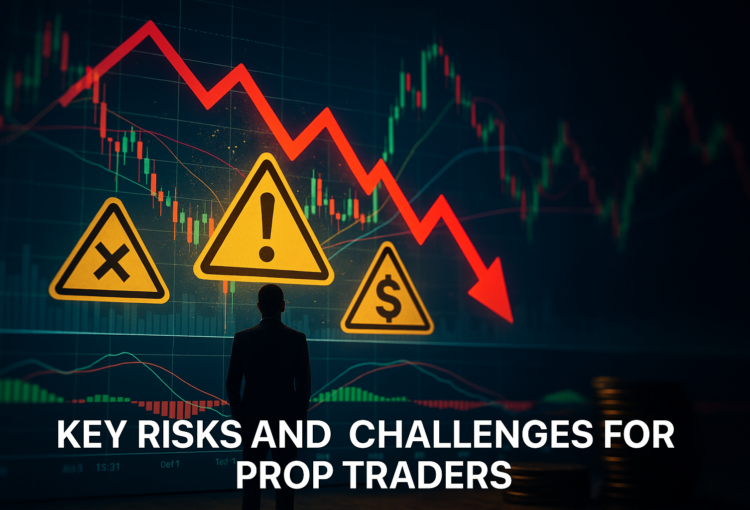Prop Trading | Imagine getting paid to trade someone else’s capital, even overnight and on weekends, while navigating a $2 trillion crypto market that never sleeps. In early 2025, a dramatic weekend plunge wiped out nearly $150 billion in market value following geopolitical turmoil, prompting major firms like Qube Research, Crypto.com, and Virtu to staff 24/7 weekend trading desks. Enter crypto prop trading: a model that gives skilled individuals access to firm capital, profit-sharing arrangements, and institutional-grade tools, without risking their own money. But with enticing opportunity comes real pressure, from strict risk rules to emotional tolls, raising a critical question: Is crypto prop trading a breakthrough career move in 2025, or just another hyped trend destined to fizzle? Let Flashift analyzes who wins, who loses, and whether this path deserves a place in your trading playbook.
What Is Crypto Prop Trading?

Crypto prop trading stands for cryptocurrency proprietary trading, a model where individual traders use firm provided capital instead of their own. To get started, you typically pass an evaluation challenge, showing you can manage risk while achieving a specific profit target. Once approved, you’re granted access to a funded account with strict rules, and you share profits, usually keeping between 70% to 90% of gains.
This setup gives traders a meaningful way to leverage institutional-grade capital without risking personal savings. It’s a model that rewards discipline, strategy, and consistent performance.
To Exchange Tether to Bitcoin in one second, visit Flashift.
How Crypto Prop Firms Differ from Banks and Brokers
Unlike a retail broker, where you trade your own money under flexible conditions, crypto prop firms set strict boundaries. You trade firm capital, and that comes with:
• Evaluation-based access: You prove your skills before you trade live.
• Rules and restrictions: Limits on drawdowns, position size, trading style, and daily losses.
• Profit share: The firm takes a portion of your earnings in exchange for providing capital and infrastructure, very different from paying broker fees.
In contrast, banks or hedge funds use their capital internally, while brokers facilitate your trades for commission, but neither structure gives you access to this hybrid model of funding, tools, and profit-sharing.
Popular Models, Challenges, Instant Funding & Profit Splits
Crypto prop firms usually offer two main schemes:
1. Challenge-based model, You pay a fee (often $100–$1,000) to enter a two-stage evaluation: hit profit targets while avoiding rule violations (e.g., no daily drawdown over 4%). Pass it, and you get funded.
2. Instant funding model, After a simpler assessment, you instantly receive a funded account. These often come with dynamic profit splits (e.g., 80% initially, scaling to 90%) and rules on drawdowns and scaling.
Either way, your success hinges on trading skill, strict risk management, and following the firm’s rules. Brokers and banks don’t offer this tailored, empowered access to capital—this is proprietary funding for the motivated.
Why Prop Trading Is Gaining Momentum in 2025

One of the biggest draws of crypto prop trading in 2025 is getting serious capital without personal risk. Instead of trading your funds, you can tap into a proprietary trading firm’s capital, sometimes scaling to $100,000 or more—just by passing an evaluation challenge. That means you can execute larger strategies and capture bigger opportunities, while only risking your performance, not your wallet. It’s not hard to see why this model is attracting ambitious traders from around the world.
24/7 Crypto Markets & Volatility as an Advantage
Crypto markets don’t take weekends off, and neither do volatile price swings. A single weekend crash wiped out nearly $150 billion after global events triggered 15% drops in Ether. That has prompted firms like Qube Research, Virtu, and Crypto.com to hire weekend traders and staff 24/7 teams. Prop trading firms, in particular, can capitalize on these unusual moves by giving skilled traders access to firm capital around the clock—turning volatility into opportunity.
Tech Improvements: Tools, Platforms, and Analytics
Modern prop firms aren’t just handing out capital, they’re also equipping you with institution-grade technology. In 2025, they’re increasingly integrating AI-driven analytics, low-latency trading systems, and automated execution tools. Some even explore quantum computing for back-testing and strategy optimization .
These tech enhancements give traders an edge by boosting execution speed, improving trade signals, and minimizing slippage, all while maintaining strict risk management frameworks. It’s not just a funding model, it’s a full-service trading ecosystem.
Key Risks and Challenges for Prop Traders

Prop trading firms enforce strict performance rules to preserve capital and ensure disciplined trading. You’ll face limits like daily drawdown thresholds, maximum position sizes, and automatic stop-outs. Violating these rules means losing your funded account, and you may need to requalify or pay another evaluation fee. Staying within these limits demands consistent strategy execution and emotional control, fall short even once, and your opportunity could vanish overnight.
Volatility & Leverage in Crypto Markets
Crypto markets are known for their unpredictability. While volatility can generate profits, it can also cause sudden and heavy losses. When combined with leverage, commonly used in prop trading, small price shifts can dramatically impact your equity. It’s crucial to manage positions carefully, implement stop-loss orders, and stay alert for flash crashes or weekend pump/dump cycles. Without proper risk management strategies, one unexpected event could wipe out your gains—or even your entire account.
Regulatory, Custody & Compliance Concerns
Operating in crypto means navigating a fast-changing regulatory landscape. The FATF has flagged crypto as vulnerable to illicit use, with about $51 billion moving into illicit wallets in 2024. In response, firms must align with evolving global standards and local regulations, whether in KYC, custody, or transaction reporting.
In the U.S., recent SEC and FINRA updates have clarified crypto-custody rules for broker-dealers, but jurisdictional uncertainty remains. Meanwhile, in the EU, the Markets in Crypto-Assets (MiCA) regulation is already in effect, creating national compliance requirements that may complicate cross-border trading.
For prop traders, this uncertainty can impact everything from account accessibility to withdrawal options and legal liability. Staying informed and choosing regulated prop firms are crucial for avoiding surprises.
Read More: AI in Cryptocurrency Trading: Opportunities and Risks
| Risk Type | Potential Impact |
| Rule breaches | Loss of funded account and possible fees |
| High volatility | Sudden drawdowns can end trades quickly |
| Regulatory changes | Impacts custody, execution, and legal standing |
Evaluating the Top Crypto Prop Firms of 2025
When it comes to crypto-focused prop firms in 2025, a few names consistently rise to the top. FTMO, a veteran firm, still dominates with over 4.43 million monthly visits, making it the most trafficked firm worldwide. Although built around forex and equities, FTMO has adapted for crypto: it offers structured two-step challenges, tight risk management, and up to 90% profit split, along with strong Trustpilot reviews praising its reliability and responsive support.
FundedNext has quickly become a top alternative. It offers up to $200k funding, profit splits starting at 80% (rising to 95%), flexible challenge structures, and fast payouts—even allowing weekend holds—features that appeal to active crypto traders . On review platforms like FxVerify, it’s praised for its challenge pricing and payout speed.
HyroTrader stands out as a crypto-native prop firm. Built specifically for digital asset trading, it supports real-exchange data (e.g., ByBit), instant payouts, and access to up to $400k in capital with profit splits up to 90% . Its focus on crypto strategy and instant funding has earned it high marks in recent top-firm lists.
Other notable providers include Crypto Fund Trader, Goat Funded Trader, Funding Pips, and The5ers, which offer innovative scaling models, high profit splits (up to 100%), and more prescriptive trader support.
Real Trader Feedback & Traffic Metrics
FTMO commands strong trust across user reviews: a 4.8-star rating on Trustpilot based on ~24,000 reviews. Traders often praise its efficient support, clear rules, and high-quality technical infrastructure.
FundedNext and HyroTrader receive positive feedback for their user-friendly funding structures and crypto-specific alignment. FundedNext enjoys a 4.6 Trustpilot score, noted for quick payouts and supportive environments . HyroTrader, although newer, is recognized for building a strong brand among crypto traders.
In terms of online visibility, Funding Pips is closing in on FTMO, with approximately 4.38 million monthly visits, ranking just ahead of FTMO in global traffic. Goat Funded Trader and The5ers follow as well-known alternatives.
The Future Outlook, Hype or Sustainable Opportunity?
Crypto prop trading is moving from niche to mainstream. Analysts predict continued growth driven by 24/7 digital asset markets, generous capital access for talented traders, and a growing emphasis on advanced tech infrastructure like AI-powered analytics and automated execution tools.
As more firms target crypto-native traders and funding pools exceed hundreds of thousands per account, the boundary between retail and institutional trading is blurring. If this trajectory holds, prop trading could become a legitimate career path for disciplined crypto traders by late 2025.
Regulatory Developments on the Horizon
Regulatory certainty is both a catalyst and a hurdle. In the U.S., the SEC has formed a crypto task force, and legislation like FIT21 is under consideration to establish clear jurisdiction between the SEC and CFTC. Meanwhile, the EU’s MiCA regulation is now in force, although ESMA is still working to harmonize oversight across member states and consider including crypto-focused prop firms under its remit.
On-the-ground, this means prop firms must adapt quickly, implementing KYC/AML protocols, custody compliance, and transparent reporting. Traders should expect tightened rules on leverage, cross-border operations, and profit-sharing disclosures. The expansion of oversight may weed out weaker operators, but it will also build trust and legitimacy for compliant, forward-thinking firms.
What Traders Should Monitor in 2025
If you want to stay ahead in crypto prop trading, keep an eye on these key trends:
• Regulatory clarity – Watch for updates to FIT21 in the U.S., crypto-specific guidelines from the SEC and CFTC, and how MiCA continues to shape EU policy.
• Tech integration – Firms adopting AI-based strategy analytics, low-latency platforms, and potential DeFi-esque treasury models could lead the field.
• Trusted reputation – As the space matures, firms with audited performance, transparent profit structures, and strong user reviews will outshine the noise.
• Geographic shifts – Crypto-friendly jurisdictions like Dubai, Singapore, and some U.S. states may become prop-trading hubs.
Crypto prop trading in 2025 is no short-lived trend, it’s evolving into a legitimate, tech-enhanced, globally regulated profession. Yes, hype exists. But for traders who focus on disciplined execution, stay regulatory-aware, and choose established prop firms, the path offers real opportunity with serious upside.
Is Crypto Prop Trading a Sustainable Opportunity in 2025?
Crypto prop trading is swiftly evolving from trend to profession. With firm-funded accounts, 24/7 market access, and institution-grade platforms, it offers a compelling path for skilled traders seeking capital without upfront personal risk. Firms equipped with AI analytics, low-latency infrastructure, and compliance-ready frameworks are making prop trading more credible and accessible than ever.
However, the road ahead hinges on regulatory clarity. In the U.S., the SEC’s new crypto task force and moves away from strict alternative trading system rules signal a more coherent regulatory environment. Meanwhile, Europe’s MiCA and anticipated U.S. legislation under FIT21/DCCPA are shaping safer, more transparent frameworks.
For traders, this spells both opportunity and obligation. The opportunity lies in leveraging prop trading’s advantages—access to capital, tight discipline, and advanced tools. The obligation lies in embracing strict risk management and staying updated on regulatory developments around KYC, AML, custody, and global compliance.
Crypto prop trading in 2025 is far more than hype, it’s a structured, tech-enhanced, globally regulated profession. But real success depends on choosing the right firm, applying disciplined execution, and staying legal. If you’re prepared to meet those standards, this era of prop trading isn’t just a trend, it’s a genuine career blueprint for the future.
FAQs
1. What is crypto prop trading?
Crypto prop trading (proprietary trading) lets traders access firm-provided capital—not their own—to make trades. You typically pass a profit-and-risk evaluation, receive a funded account, and split profits with the firm (typically keeping 70 – 90%).
2. How do I qualify for a funded account?
Prop firms require you to pass a challenge: meet profit targets while adhering to risk rules (e.g., max drawdown, trade limits). Passing gives access to live funds; violating rules may reset your progress.
3. What are common trading structures?
Two main models exist:
• Challenge-based: Pay a fee ($100–$1,000), pass a multi-stage evaluation, and then access funding.
• Instant-funding: A lighter vetting process that grants immediate access, often with dynamic profit splits (e.g., 80–90% to traders.
4. Do I need my own capital to start?
No, crypto prop trading uses firm capital. You only invest skill and discipline. Your personal funds aren’t at risk unless you violate rules or fail challenges.
5. What types of strategies are supported?
Prop firms support diverse strategies: news trading, trend following, momentum, scalping, and market-making. Crypto markets’ 24/7 volatility allows traders to apply these around the clock.
6. What risks should I anticipate?
Key risks include:
• Rule violations (stop-outs, rule breaches) can cost you the account.
• High leverage & volatility may amplify losses.
• Regulatory uncertainty around custody, reporting, and KYC/AML.
7. Is crypto prop trading worth it?
It depends. With access to institutional capital, transparent risk frameworks, and cutting-edge tools (AI, low-latency systems), it’s a serious opportunity—but only for disciplined, risk-aware traders.







